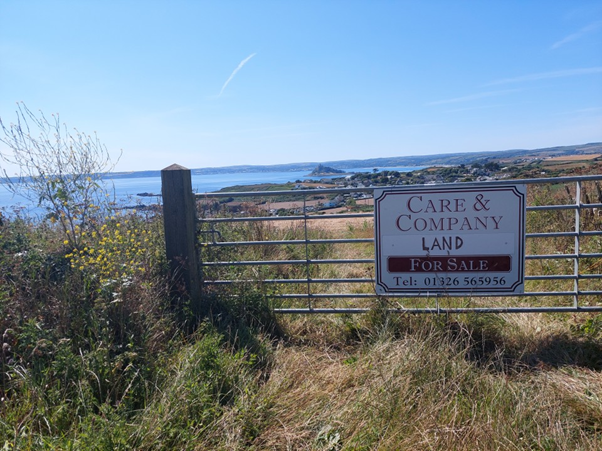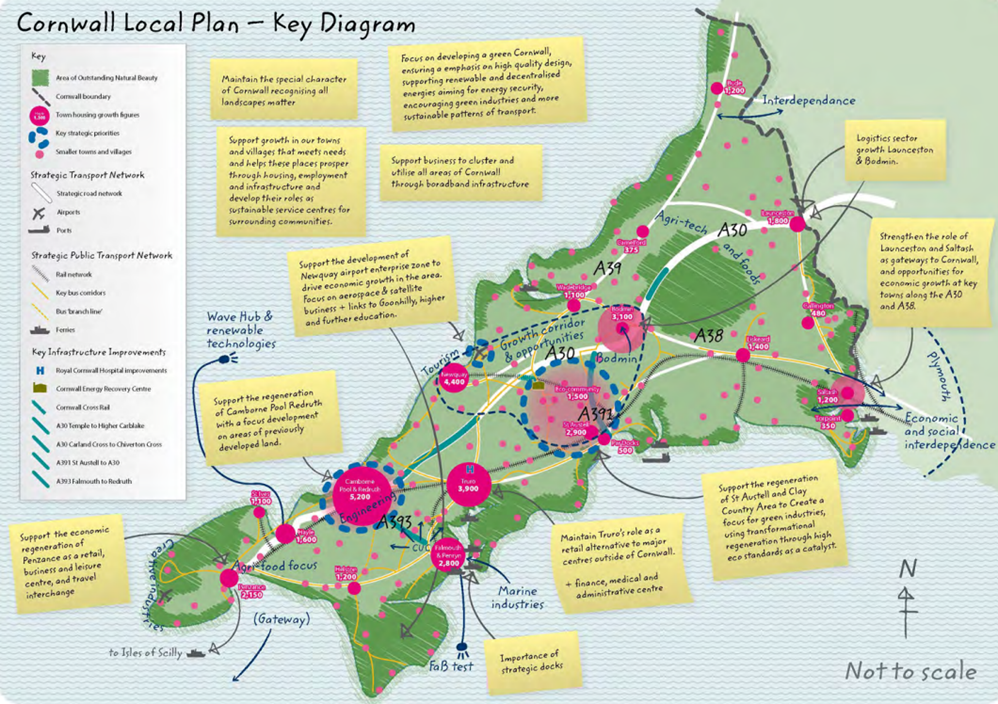Charles Goode is a Teaching Fellow in Urban and Regional Planning at the University of Birmingham.
After a very busy academic year, my recent holiday to West Cornwall was not intended to be planning-related, but planning featured throughout my journey. This included a flying visit to the amazing Castle Drogo in Dartmoor. It was designed by the famous architect Sir Edwin Lutyens who, along with Sir Patrick Abercrombie, authored 'A Plan for the City'. This was a post-war Plan for Kingston upon Hull which proposed a Green Belt that was never implemented.
Another planning-related feature were the fascinating original documents in Jamaica Inn from the public consultation on the various routes for dualling of the A30.

A document from the public consultation on the dualling of the A30 at Jamacia Inn
Furthermore, a very attractive piece of land adjoining the holiday bungalow where we used to stay when I was a child is now for sale near St Michael's Mount. It will be interesting to see if the land is developed for housing in the fulness of time which will, in turn, affect the landscape of the Bay.

Land for sale in Mount’s Bay
These examples highlight the importance of strategic planning so this article will explore the lessons we can learn about it from the Duchy.
What works well
1. A Local Plan is in place
At a time when many local authorities are struggling to implement and adopt local plans, Cornwall has a Local Plan which aims to guide development strategically. Refreshingly, the Plan covers the whole county - a significant area (at 3,562km2 not far off the size of Kent) - and tries to steer housebuilding towards areas in need of investment, especially Camborne-Redruth and St Austell. Counties are imperfect, artificial geographies but planning at that level gives more of a strategic perspective than the purely local level. Of course, Cornwall is a unitary authority and potential plans in the Devolution White Paper to forcibly unitarise district councils appear to be no longer likely but, with the merging of district councils and the emergence of unitary authorities like Dorset and Buckinghamshire Councils, there are important lessons which can be learnt from Cornwall's Local Plan.

The ’Key Diagram’ from the Cornwall Local Plan (p. 99)
2. The Plan is relatively strategic
Like other unitary (county) authorities, such as Herefordshire, the Plan is relatively strategic in terms of allocating growth locations whilst leaving scope for smaller communities to build housing for local need and steer development through the Neighbourhood Plan process. In this way, lessons can be learnt from the principle of subsidiarity or that certain spatial governance scales are more appropriate for making (planning) decisions than others and shows the benefit of planning at the county level.
3. The establishment of Cornwall Council has professionalised planning more in the Duchy
In a general sense, Cornwall has been very successful at safeguarding its historic human and natural heritage such as the beautifully preserved harbours of St Ives or Mousehole.

Mousehole Harbour

St Ives
Nonetheless, historically there have been individual cases of poor-quality development in sensitive locations which leads to questions as to why planning permission was granted in the first place. However, Cornwall Council has been successful more broadly at further professionalising planning and ensuring decisions are made more in the broader interests of the county.
What needs improvement
1. Cornwall has a severe and deepening housing crisis
Cornwall is a wonderful place to live for those who can afford it but to those who can’t the cost of accommodation is becoming prohibitiveThis has a wide range of ramifications including affecting the feasibility of maintaining shops and facilities year round in coastal locations whilst contributing to the wider 'brain drain' of young people from the county and the challenges of housing key workers. Of course, many of these challenges are wider than the planning system and relate to Council Tax (there have been recent changes on this front) as well as the broader property market and cultural preferences etc. Nonetheless Planning Consultant Jonathan Jenkin argued there are important ways that the planning system could more successfully manage second homeownership through, for example, creating a distinctive holiday and second home class in the National Planning Policy Framework. Moreover, the tremendous need for affordable housing in the Duchy is a significant challenge for plan-making in a county heavily constrained by coastal topography as well as Areas of Outstanding Natural Beauty (AONB) etc.
2. There are challenges with cross-county cooperation
On my way down to Cornwall, we stopped for a meal in a pub in Chagford (Devon). When I said that I was going onto Cornwall, the manager joked 'that's a different country'! However, in many ways the housing market area of Plymouth stretches to Saltash and beyond whilst the success of Plymouth's economy is vital, particularly to South East Cornwall. Whilst there maybe strong popular opposition to accommodating development from the 'other side of the Tamar', cross-boundary cooperation is an important strategic planning challenge which must be grappled with.
3. There are broader difficulties about the (perceived) representativeness of Cornwall Council
Moving towards a unitary authority makes sense administratively and from a planning point of view but it can be extremely unpopular with local people, especially when they feel that local autonomy has been removed. Notwithstanding the many benefits from there being a unitary council including providing one voice for Cornwall and strategic oversight of planning (which enables development to be channelled into economically deprived areas), there is still simmering popular resentment towards the establishment of Cornwall Council. A lifeguard said to me that there is even growing concern among young people that the character of Cornwall is changing irrevocably with the scale of development. Clearly much of this rhetoric reflects broader popular perspectives on opposition to housebuilding but it does highlight some of the key challenges to the democratic legitimacy of strategic planning, especially in planning for meeting housing need.
Concluding Thoughts
Strategic planning in Cornwall has particular challenges and there are positive and negative lessons which can be learnt from the attempts of Council to plan strategically. Whilw the geography of Cornwall is distinct, it shares many characteristics with other parts of the country including a spectacular natural environment and large areas of AONB, pockets of extreme wealth and areas of deep deprivation and issues with second homeownership and overheated property markets. There are also the challenges of perceived peripherality (despite reasonable road and rail links), balancing protection of historic heritage with the need to modernise housing stock whilst working through some of challenges of the move towards the renewable economy such as onshore wind. As more councils move towards unitarisation, there is therefore much that can be learnt from the Duchy.

Newquay from Carland Cross
For a fuller exploration of the key lessons which can be learnt regarding strategic planning, please see my Open Access article on the West Midlands Green Belt.
If you are interested rural planning you might also want to read Rural Planning in the 2020s, the RTPI’s latest research report.


